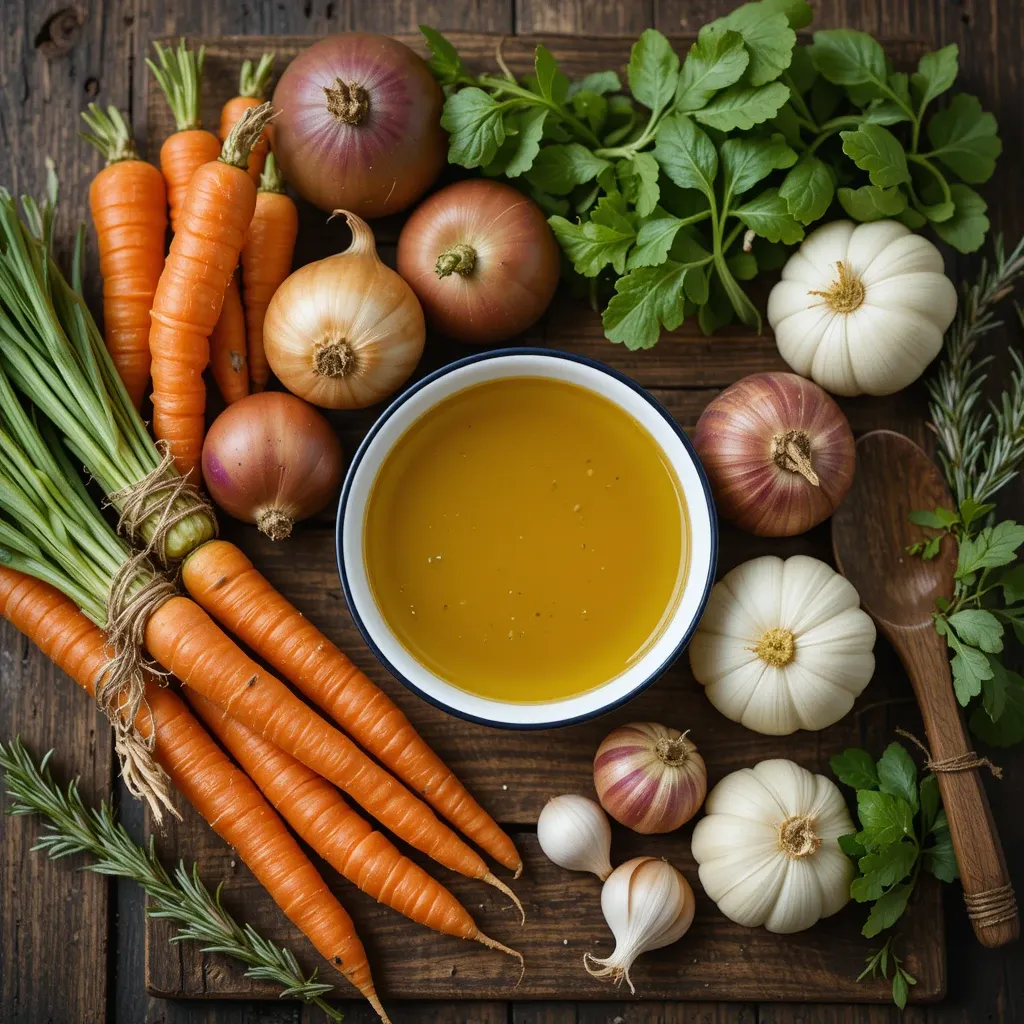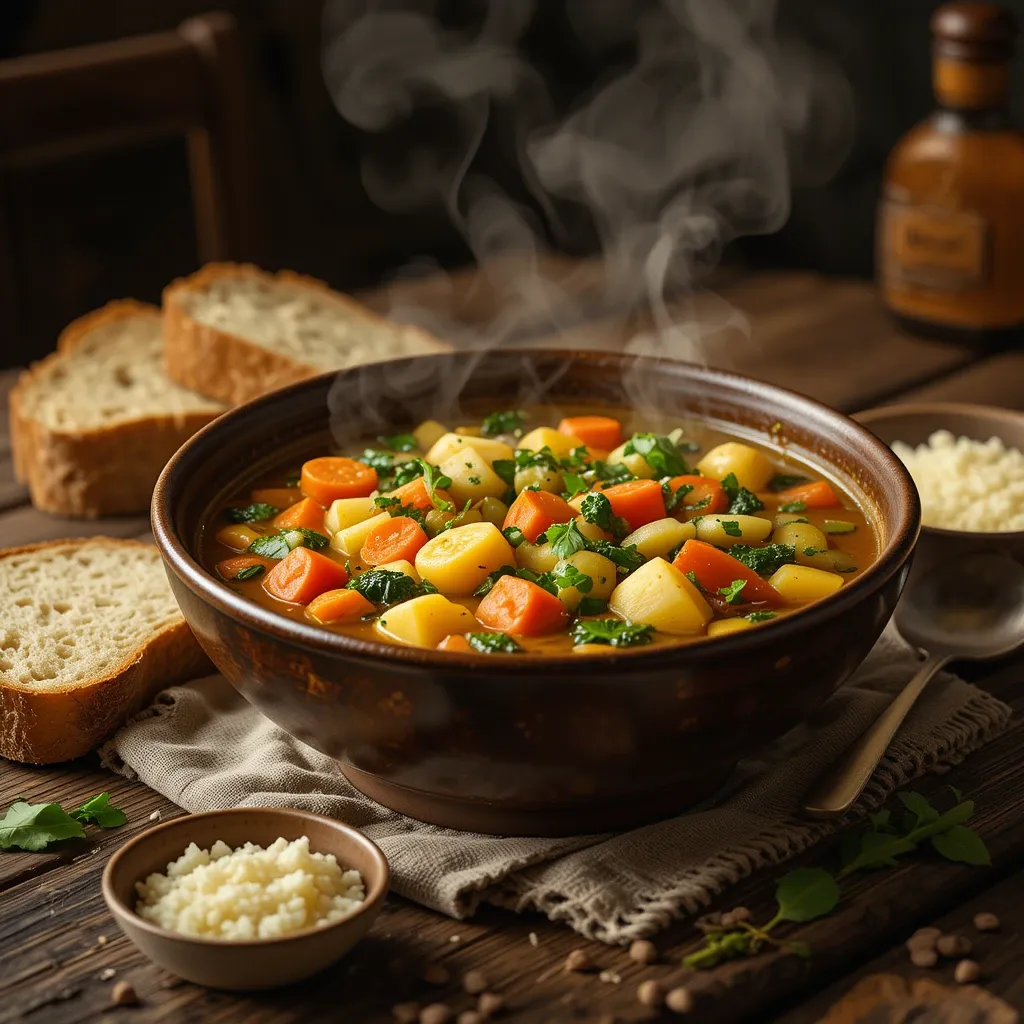Table of Contents
Nothing warms the soul quite like a steaming bowl of village soup, packed with the freshest vegetables and bursting with flavor. Have you ever wondered what makes this rustic dish so special? It’s the perfect harmony of hearty ingredients, nourishing goodness, and the comforting taste of tradition. Whether you’re seeking a wholesome meal for chilly evenings or a versatile recipe to showcase seasonal produce, village soup has you covered. Let’s dive into the key ingredients that turn a simple bowl of soup into a celebration of nature’s bounty.
Key Benefits of Adding Vegetables to Village Soup
Village soup is more than just a comforting dish—it’s a powerhouse of nutrition and flavor. Here’s why adding the right vegetables can take this recipe to the next level:
- Nutritional Boost: Packed with vitamins, minerals, and antioxidants, vegetables like carrots, spinach, and zucchini enhance the health benefits of your soup, supporting immunity and overall well-being.
- Rich Flavor Profile: Root vegetables such as potatoes and parsnips add earthy sweetness, while aromatic ingredients like onions, garlic, and celery build a savory base.
- Versatility: You can adapt the recipe based on the season. Think vibrant tomatoes and bell peppers in summer or hearty squash and leeks in winter.
- Fiber for Fullness: Adding fiber-rich vegetables like kale or cabbage makes the soup hearty and satisfying, perfect for a wholesome meal.
- Budget-Friendly: Using seasonal produce keeps this dish economical while maximizing freshness and taste.

Ingredients for Village Soup
Gathering the right ingredients is the first step to creating a flavorful and nutritious village soup. Here’s what you’ll need:
Fresh Vegetables (The Stars of the Dish):
- Carrots: For a touch of sweetness and vibrant color.
- Potatoes: Add heartiness and make the soup satisfying.
- Onions and Garlic: Build a robust and aromatic flavor base.
- Celery: Brings a hint of freshness and crunch.
- Zucchini or Squash: Perfect for a light, summery twist.
- Leafy Greens: Spinach or kale for added nutrition and texture.
Broth or Stock:
- Vegetable Broth: Ideal for a vegetarian or vegan option.
- Chicken or Bone Broth: For a richer, more savory flavor.
Herbs and Seasonings:
- Fresh Thyme or Rosemary: Infuses the soup with a rustic, earthy aroma.
- Bay Leaf: A classic addition to elevate the overall flavor.
- Salt and Black Pepper: Essential for balance and depth.
- Paprika or Chili Flakes (optional): For a hint of warmth and spice.
Optional Add-Ins:
- Tomatoes: Fresh or canned, for a tangy twist.
- Legumes: Chickpeas or lentils to boost protein and texture.
- Grains: Barley or rice for a filling, hearty variation.
Feel free to swap ingredients based on what’s available or your personal preferences. By combining these simple, wholesome components, you’ll create a village soup that’s comforting, flavorful, and easy to customize.

Serving and Pairing Suggestions for Village Soup
Now that your village soup is bubbling away, let’s talk about how to serve and pair it for the perfect meal experience. Whether you’re enjoying it on its own or with complementary sides, there are endless ways to elevate this dish.
Ideal Pairings:
- Crusty Bread: A thick slice of rustic sourdough or a baguette is perfect for soaking up every drop of soup.
- Salad: A fresh, crisp green salad with a tangy vinaigrette adds a refreshing contrast to the warmth of the soup.
- Cheese: A sprinkle of grated Parmesan or a dollop of creamy goat cheese can add richness and depth.
- Grains: Serve with a side of fluffy rice or quinoa to create a well-rounded meal.
Beverage Suggestions:
- Herbal Tea: A light chamomile or mint tea pairs beautifully with the natural flavors of village soup.
- Light Wine: A crisp white wine, such as Sauvignon Blanc, complements the freshness of the vegetables.
- Infused Water: Serve with chilled water infused with lemon or cucumber for a refreshing touch.
Presentation Tips:
- Garnishes: Add a handful of fresh herbs (like parsley or basil) on top for a burst of color and fragrance.
- Serve in Rustic Bowls: A wide, shallow bowl adds a rustic charm and allows you to enjoy the soup’s full aroma.
With these simple yet thoughtful pairings, your village soup will not only nourish the body but also delight the senses.

Pro Tips and Variations for Your Village Soup
Creating the perfect village soup is all about flexibility and flavor. Whether you’re a seasoned cook or just starting out, here are some pro tips and creative variations to help you make this dish your own.
Pro Tips for Success:
- Build Depth of Flavor: Start by sautéing your onions, garlic, and celery in olive oil until they’re soft and fragrant. This creates a rich base for the soup.
- Don’t Skip the Simmer: Allow your soup to simmer gently for at least 30-40 minutes. Slow cooking brings out the natural sweetness of the vegetables and helps the flavors meld together.
- Season Gradually: Taste as you go! Add salt, pepper, and herbs slowly, adjusting to your taste. Too much at once can overpower the dish.
- Add Acidity: A splash of lemon juice or a small splash of vinegar at the end brightens the soup and balances the flavors.
Creative Variations to Try:
- Vegan Village Soup: Simply swap out any meat-based broth for vegetable stock and skip the cheese topping for a completely plant-based version.
- Spicy Kick: Add a pinch of chili flakes or a dash of hot sauce for a fiery twist.
- Protein Power: Stir in cooked beans, lentils, or chickpeas for a heartier soup that’s packed with plant-based protein.
- Creamy Texture: Blend half of the soup in a blender for a smooth and velvety texture, then return it to the pot. You can also add a splash of coconut milk for a subtle creamy flavor.
Customizing to Your Taste:
- Seasonal Veggies: Don’t hesitate to adjust the vegetables based on what’s available. Winter root vegetables like turnips and parsnips make a wonderful substitution for potatoes.
- Grains and Legumes: If you want to make the soup even more filling, try adding some cooked quinoa, barley, or even pasta. These additions give the soup more texture and help it stretch further.
By incorporating these tips and variations, you’ll elevate your village soup to new heights, ensuring each batch is uniquely satisfying!

Serving Suggestions for Village Soup
Now that your village soup is perfectly simmered and packed with flavor, it’s time to think about how to serve it. Presentation and thoughtful pairings can take this simple, comforting dish to the next level. Here are some ideas to help you serve it with style and flavor!
Garnishes for Extra Flavor:
- Fresh Herbs: Sprinkle freshly chopped parsley, thyme, or basil over the top to add a burst of color and a fresh finish.
- Grated Cheese: A light dusting of Parmesan, cheddar, or crumbled feta can add richness and depth.
- Croutons: Homemade or store-bought, croutons give the soup a delightful crunch and extra texture.
- Drizzle of Olive Oil: A small drizzle of high-quality extra virgin olive oil adds a smooth, luxurious finish to the soup.
Perfect Sides to Serve With:
- Warm Bread: Serve with a slice of crusty baguette, sourdough, or a soft dinner roll. The bread is perfect for dipping and absorbing the soup’s savory goodness.
- Salad: A simple side salad with a tangy vinaigrette is a refreshing contrast to the richness of the soup. Try mixing arugula, spinach, and a few cherry tomatoes for a light, crisp side.
- Grains: If you’re looking for a heartier meal, serve the soup alongside some fluffy quinoa or rice to soak up the broth.
Drink Pairings:
- Herbal Tea: A calming chamomile or refreshing mint tea pairs perfectly with the soothing flavors of village soup.
- Light Wine: A glass of crisp white wine, such as Sauvignon Blanc or Chardonnay, complements the fresh vegetables and herbal notes in the soup.
- Infused Water: Serve with cucumber or lemon-infused water to keep things light and refreshing.
With these serving ideas, your village soup will become a comforting, full meal that’s both visually appealing and satisfying. Enjoy it with your favorite sides and drinks, and make the experience even more enjoyable!
Conclusion: Why Village Soup is a Must-Try
Village soup is more than just a meal—it’s a comforting tradition that brings warmth, flavor, and nourishment to your kitchen. By using fresh, seasonal vegetables, you create a bowl that is as healthy as it is hearty. Whether you’re making it for a cozy dinner, a family gathering, or simply for a week’s worth of lunches, this soup is versatile and easy to customize.
With its rich depth of flavor and wholesome ingredients, village soup is the perfect dish to make any day feel special. And the best part? It’s endlessly adaptable! You can switch up the vegetables, add your favorite herbs, or even throw in some grains or legumes for extra heartiness.
So, grab your favorite veggies, and let this recipe inspire you to create a nourishing meal that’s full of love and flavor. Each spoonful is a reminder of how simple, good food can be. Enjoy!
FAQ
We know that sometimes making a new recipe can come with questions, so here are some common FAQs about village soup to help guide you on your cooking journey.
Can I make village soup ahead of time?
Absolutely! Village soup actually tastes even better the next day as the flavors have more time to meld together. You can store it in an airtight container in the fridge for up to 4 days. For longer storage, freeze the soup for up to 3 months. Just be sure to let it cool completely before freezing.
Can I use frozen vegetables in this soup?
Yes, you can! Frozen vegetables are a great time-saver and still retain much of their flavor and nutrients. Just be mindful of their cooking times—frozen vegetables tend to cook faster, so you may want to add them toward the end of the simmering process.
How do I make village soup spicier?
If you prefer a bit of heat, there are several ways to spice up your village soup:
- Add chili flakes or a chopped fresh chili.
- Stir in a bit of hot sauce or cayenne pepper.
- For a smoky heat, try adding smoked paprika.
Can I substitute the broth for something else?
Yes! If you’re looking for a lighter option, use water with extra herbs or a vegetable bouillon cube. For a richer taste, beef broth or chicken stock can be used. If you prefer a vegetarian version, stick to vegetable broth for the best flavor.
How do I make the soup thicker?
If you prefer a thicker consistency, try these tricks:
- Blend part of the soup: Use an immersion blender or a regular blender to purée half of the soup and return it to the pot.
- Add mashed potatoes or lentils: These ingredients naturally thicken the soup while adding more texture.
Can I add meat to village soup?
Yes! Adding meat like shredded chicken, sausage, or bacon can enhance the flavor. Brown the meat in the pot before adding your vegetables for an extra layer of richness.
These tips and answers should help you feel confident in making the best village soup every time. If you have any more questions, feel free to drop them in the comments—we’re always happy to help!

